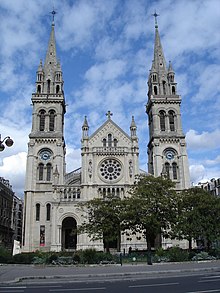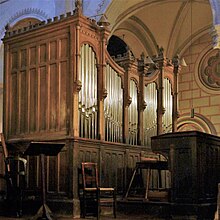St-Ambroise (Paris)
Saint-Ambroise is a Roman Catholic church in the 11th arrondissement of Paris . It gave its name to the Quartier Saint-Ambroise and the metro station Saint-Ambroise .
The building has been a Monument Historique since 1978 and is a listed building.
Building history
First church
A first church building was built in 1659 by the congregation of the Annuntiate Sisters , who had been located on Rue Popincourt since 1636 . The order was abolished in 1780 and in 1781 two streets were built on the site of the former convent , the Rue Saint-Ambroise and the Rue de Beauharnais , the latter was rededicated in 1818. After being secularized , the church was sold on the 2nd Prairial of year V (May 21, 1797). From 1802 it served as a branch church of the parish of Sainte-Marguerite . After the city of Paris bought it back on August 31, 1811, the church was restored and enlarged by Étienne-Hippolyte Godde and rededicated on November 15, 1818.
In contrast to the traditional alignment of church buildings, Saint-Ambroise is built on the axis of Rue Popincourt in a north-south direction. It was surrounded by buildings to the west and south. It was demolished for the piercing of Boulevard Voltaire and a square, Square Saint-Ambroise , was created in its place .
Second church
construction

Reconstruction of the church was declared a "public need" on January 24, 1863.
The current church on Boulevard Voltaire 71 was built between 1863 and 1868 according to plans by the architect Théodore Ballu and under his direction. The construction took place shortly after the completion of the Boulevard du Prince-Eugène , as the Boulevard Voltaire was called at that time.
The style is a mixture of neo-Gothic , neo-Romanesque and neo-Byzantine elements, which was very popular in the capital of France at the time. The two slender spiers are reminiscent of those of some cathedrals.
Paris Commune
During the time of the Paris Commune in 1871, the church became the seat of the proletarian club of feminist speakers known as the Club Ambroise , without affecting the services . This club published the magazine Le prolétaire . After May 23, 1871, the church became a weapons and ammunition store.
Consecration
The Saint-Ambroise church was consecrated on December 7, 1910 by Cardinal Léon-Adolphe Amette .
Interior
- L'Espérance (Hope) and La Foi (Faith), allegorical stone figures by Louis-Denis Caillouette , 1829, lost
- L'Immaculée Conception (Immaculate Conception), sculpture by Caillouette, exhibited at the Paris Salon in 1824.
Organs
The gallery organ is a work by Merklin- Schütze from 1869. It comprises 32 stops on three manuals and a pedal . It was restored by Gutschenritter in the 20th century.
There is also a smaller choir organ with 12 registers on two manuals and a pedal, which was also built by Merklin at the end of the 19th century.
Gallery organ
|
|
|
|
||||||||||||||||||||||||||||||||||||||||||||||||||||||||||||||||||||||||||||||||||||||||||||||||||||||||||||||
- Normal coupling : II / I, III / II, III / I, I / P, II / P, III / P
- Playing aids : Fixed combinations (tongues, tutti)
Choir organ
|
|
|
||||||||||||||||||||||||||||||||||||||||||||||||||||
- Normal coupling : II / I, I / P, II / P
- Playing aids : tongue extension II
Individual evidence
- ^ Entry in the directory of the Monuments historiques , accessed on February 14, 2016
- ^ Félix Lazare, Louis Lazare: Dictionnaire administratif et historique des rues de Paris et de ses monuments . 1844, p. 9, online
- ↑ Cadastre de Paris par îlot (1810-1836) , plan 30 e quartier Popincourt, îlots N os 6 et 6bis, échelle 1/625, côte F / 31/87/07
- ^ Joseph Garin: Les Annonciades de Popincourt (1636-1782). Leur établissement, les deux premières supérieures . In: Revue d'histoire de l'Église de France , 1910, vol. 1, N o 5, pp. 533-554 online
- ↑ Adrien Deville, Émile Hochereau: Ville de Paris . Recueil des lettres patentes, ordonnances royales, décrets et arrêtés préfectoraux concernant les voies publiques. Ed .: Adolphe Alphand. Imprimerie nouvelle (association ouvrière), Paris 1886, p. 332 ( online [accessed February 14, 2016]).
- ↑ Jean braire: Sur les traces of the Communards: enquête dans les rues du Paris d'aujourd'hui . Editions Amis de la Commune, Paris 1988 p. 110
- ↑ Christine Fauré: Political and Historical Encyclopedia of Women . Routledge 2004, p. 378
- ↑ Orgues de Paris . Composition du grand orgue.
- ↑ Orgues de Paris . Orgue de chœur.
Web links
Coordinates: 48 ° 51 ′ 39.9 ″ N , 2 ° 22 ′ 32 ″ E



